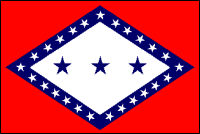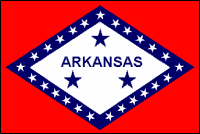The Arkansas State Flag
The battleship U.S.S. Arkansas was to be commissioned and the Pine Bluff chapter of the Daughters of the American Revolution voted to present an Arkansas State Flag to the ship. The committee dutifully sent a letter off to Secretary of State Earl W. Hodges to learn more about the flag. They received a reply to their letter explaining that Arkansas had no state flag.
The Pine Bluff Daughters decided that this situation had to be corrected and sponsored a statewide flag design contest. Secretary of State, Hodges chaired the committee to select the flag design and chose a distinguished group to assist him: Dr. Junius Jordan, the Chairman of Philosophy and Pedagogy at the University of Arkansas; Mrs. Julia McAlmont Noel, a member of the John McAlmont chapter of the D.A.R. in Pine Bluff; Miss Julia Warner, a teacher in the Little Rock school system, and Mrs. P.H. Ellsworth, a former president of the Arkansas Federation of Women's Clubs.
Sixty-five entries were received in different formats, from crayon drawings to miniature silk flags. Many of the entries featured the state flower, the Apple Blossom, in different settings. The entry chosen was a red, white and blue design by Miss Willie Hocker of Wabbaseka, a member of the Pine Bluff chapter of the D.A.R., where the idea for the contest originated.
The design depicted a large white diamond bordered by twenty-five stars on a blue band. A straight line of three blue stars was centered in the diamond. The flag committee thought the state's name should be on the flag. Miss Hocker agreed and suggested that the blue stars be re-arranged with one star above the name and two below.
The Arkansas Legislature adopted Miss Hocker's design as the official state flag of Arkansas. The U.S.S. Arkansas received this flag from the Pine Bluff chapter of the D.A.R....
Wait!... There's more.
Trouble was brewing. The design committee had neglected to consider the role of Arkansas as a member of the Confederate States of America from 1861 to 1865. To correct this, in 1923 the Legislature voted to add another star above the state name. This fourth star was placed above the letter "R" in Arkansas and the original star above the name was moved to a position above the last "A" in Arkansas.
This time uproar came from those who claimed the addition of the fourth star compromised the original meaning and symmetry of the design. So, in 1924, the Arkansas Legislature addressed the design of the state flag again. The original three stars were moved below the state name and the additional star was centered above the state name. This is the way the flag is today.
The flag displays a white diamond on a red field. The white diamond is bordered by a band of blue containing twenty-five stars. The state name is centered in the diamond. Three stars are placed below the state name and one is centered above the state name.
The colors of the flag, red, white and blue associate the state with the United States of America. The three blue stars below the state name represent the three countries that the territory belonged to (France, Spain and the United States), the year (1803) that Arkansas was acquired by the United States as part of the Louisiana Purchase and that Arkansas was the third state created from the purchase. The two stars below and parallel to the state name represent the twin states, Arkansas and Michigan, both admitted to the union at about the same time: Arkansas on June 15, 1836 and Michigan on January 26, 1837. The single star above the state name represents Arkansas' membership in the Confederate States of America.
Twenty-five stars in the blue band represent Arkansas as the twenty-fifth state admitted to the union. The diamond signifies Arkansas as the only diamond-producing state in the nation.
Arkansas Flag Law
The following information was excerpted from the Arkansas Code (Non annotated), Title 1,
Chapter 4.
TITLE 1. General Provisions.
Chapter 4. State Symbols, Motto, Etc.
Section 1-4-101. State Flag.
(a) The official state flag shall be a rectangle of red on which is placed a large white diamond, bordered by a wide band of blue on which are twenty-five (25) white stars. Across the diamond shall be the word "ARKANSAS" and four (4) blue stars, with one (1) star above and three (3) stars below the word "ARKANSAS". The star above the word "ARKANSAS" shall be below the upper corner of the diamond. The three (3) stars below the word "ARKANSAS" shall be placed so that one (1) star shall be above the lower corner of the diamond and two (2) stars shall be placed symmetrically, parallel above and to the right and left of the star in the lower corner of the diamond.
(b) The three (3) stars so placed are designed to represent the three (3) nations, France, Spain, and the United States, which have successively exercised dominion over Arkansas. These stars also indicate that Arkansas was the third state carved out of the Louisiana Purchase. Of these three (3) stars, the twin stars parallel with each other signify that Arkansas and Michigan are twin states, having been admitted to the Union together on June 15, 1836. The twenty-five (25) white stars on the band of blue show that Arkansas was the twenty-fifth state admitted to the Union. The blue star above the word "ARKANSAS" is to commemorate the Confederate States of America. The diamond signifies that this state is the only diamond-bearing state in the Union.
History. House Concurrent Resolution, No. 23, Acts 1953, p. 1510; A.S.A. 1947, § 5-108.
1-4-103. Lowering of flags upon death of public officials.
(a) It shall be the policy of the State of Arkansas to honor and pay tribute to certain public officials by lowering the state flags located on public buildings and other public property to half-mast from the time notice of the official's death is received through the day on which funeral services are conducted for the deceased official.
(b) This section shall apply with respect to the following officers:
(1) Current and past members of the United States Congress from the State of Arkansas;
(2) Current constitutional officers of the State of Arkansas;
(3) Former Governors of the State of Arkansas;
(4) Current members of the Arkansas General Assembly;
(5) Current members of the Arkansas Supreme Court.
(c) The provisions of this section shall not interfere with or restrict the authority of the Governor to order the state flag lowered to half-mast by executive proclamation at times other than those mentioned in this section.
History. Acts 1977, No. 534, §§ 1-3; A.S.A. 1947, §§ 5-108.1 - 5-108.3.
1-4-104. Distribution of flags.
(a) The Secretary of State is authorized and directed to obtain a sufficient quantity of flags of the United States and of the State of Arkansas in order that the flags that have been flown over the State Capitol Building may be made available to members of the House and Senate of the General Assembly and to the Governor for distribution to civic groups, schools, and organized youth groups in their respective areas.
(b) A sufficient quantity of flags shall be obtained to permit the Secretary of State to make available for distribution in the manner authorized in this section:
(1) Fifteen (15) Arkansas flags and ten (10) United States flags per calendar year to each member of the House of Representatives and the Senate;
(2) One hundred (100) flags per calendar year, which may be either Arkansas flags or United States flags as indicated by the Governor, to the Governor; and
(3) Twenty-five (25) Arkansas flags and twenty-five (25) United States flags per calendar year to:
(A) The office of the Speaker of the House of Representatives;
(B) The office of the President Pro Tempore of the Senate;
(C) The Lieutenant Governor;
(D) The Secretary of State;
(E) The Treasurer of State;
(F) The Auditor of State; and
(G) The Commissioner of State Lands.
(c) The provisions of this section shall be in lieu of any other law of this state which provides for the Secretary of State to furnish copies of flags for distribution to civic groups, schools, and organized youth groups.
History. Acts 1985, No. 414, §§ 1, 2; A.S.A. 1947, §§ 5-120, 5-121; Acts 1989 (1st Ex. Sess.), No. 123, § 14; 2003, No. 300, § 1.
Source: Arkansas General Assembly, Arkansas Code (Non annotated), June 30, 2007.
Source: Arkansas Secretary of State, Arkansas State Flag, , June 30, 2007.
Source: FOTW "Flags of the World" Web Site, Arkansas (U.S.), , June 30, 2007.
Source: State Names, Seals, Flags and Symbols: A Historical Guide Third Edition, Revised and Expanded by Benjamin F. Shearer and Barbara S. Shearer. Greenwood Press; 3 Sub edition (October 30, 2001).
Source: State Names, Flags, Seals, Songs, Birds, Flowers, and Other Symbols by George Earlie Shankle. Reprint Services Corp; Revised edition (June 1971).
Source: Flags of the Fifty States and Their Incredible Histories: The Complete Guide to America's Most Powerful Symbols by Randy Howe. The Lyons Press; First edition edition (November 1, 2002).
Additional Information
Protocol For The Arkansas State Flag:
This booklet outlines procedures for the care and use of the Arkansas State Flag. The book was compiled by a committee formed by the Secretary of State. Representatives of the Governor's Office, the Department of Education, the Girl Scouts of the U.S.A., the State History Commission, the Secretary of State's Office and the Daughters of the American Revolution made up the committee.
Arkansas (U.S.):
FOTW "Flags of the World" Web Site.
State Flags:
Complete list of state flags with links to large pictures and images suitable for coloring.
Flag Terminology:
The parts of a flag and terms associated with its design.
Visit Our Flag Shop:
Purchase all kinds of flags and banners, lapel pins, 50 state flag sets, decals, patches, college banners at the Flag Shop.
Flags of the Fifty States and their Incredible Histories:
A complete guide to America's most powerful symbols by Randy Howe.
How Proudly They Wave: Flags of the Fifty States:
This book, by Rita D. Haban, is geared toward younger readers. |





